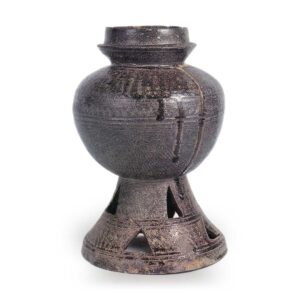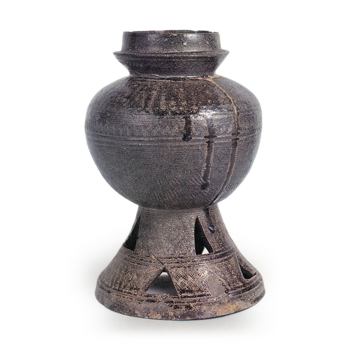
Excavated from Kinzaki Tumulus, Nishikawazu-cho, Matsue-shi, Shimane
5th century.
Height 29.6cm, Mouth diameter 10.7cm, Body diameter 21.0cm, Bottom diameter 19.5cm.
Department of Archaeology, Faculty of Letters, Kyoto University
This jar with a stand, which has a short open mouth and neck and a tall, upright lid with a curved back, is known to have been made in the latter half of the 5th century. The lid is regrettably missing. Since these ancient Sue ware jars were all round-bottomed, they were used either with pedestals or on high cup-shaped bases. The body of the jar is made of a rather coarse clay containing pebbles, and the body is rolled up with string and then formed into a basic shape using a thick stripe-shaped hammer, and secondarily formed on the potter’s wheel. These early vases with diameters of over 20 cm were all made by cord-wrapping and wheel-thrown molding, with the mouth and neck, body, and foot each made separately and joined together.
The bowls are decorated with a single section on the neck, two sections on the body, and a pedestal foot with a wavy comb pattern. The base is decorated with a staggered triangular openwork in two stages, which is characteristic of ancient Sue ware. This type of jar with a base shows characteristics that have already been Japanized. The surface is grayish black in color due to smoked reduction firing. The ware is very well fired, with a dark green natural sleeve running from the shoulder to part of the foot. This is a representative example of Koshiki Sue ware.



